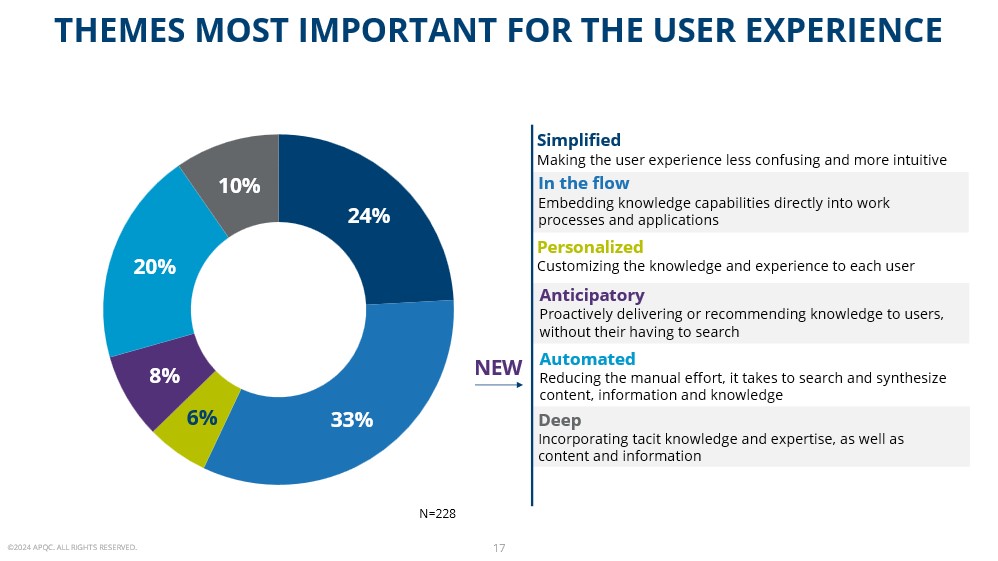Here's Why The Life Sciences Struggle To Exploit Process Knowledge
By Cindy Hubert, APQC

Complexity is a constant in the life sciences industry. Advanced modalities and rapid technological advancements only add to the evolving landscape. At the heart of navigating these challenges lie two critical disciplines: process management (PM) and knowledge management (KM). These disciplines have long been the foundation upon which organizations build resilience against disruptions and drive continuous improvement.
Process management provides the structured pathways, key activities, and guidance necessary for organizational transformation. It ensures that quality and regulatory compliance are not just met but are integral to business operations. On the other hand, knowledge management empowers organizations by harnessing insights and expertise, driving innovation, and enabling adaptability in the face of change.
Despite the industry's robust efforts in managing and enabling processes, primarily driven by quality and regulatory demands, there remains a significant gap in effectively leveraging its most valuable asset — knowledge. Ensuring that knowledge flows seamlessly to the right person at the right time is crucial for informed decision-making and timely action.
Over the years, much has been written about the importance of knowledge management in life sciences. However, the reality is that KM efforts have often been fragmented and under-resourced. This decentralization has hindered the development of comprehensive KM capabilities and competencies. The reasons for this are multifaceted. Some industry insiders suggest that the sector's financial success has led to complacency in investing in KM. Others point to a lack of commitment to build a culture of collaboration and knowledge exchange. Additionally, the sheer scale of implementing a systematic, enterprise-wide KM strategy can be overwhelming.
To truly "crack the code" of embedding knowledge management as a core business strategy, the life sciences industry must leverage its existing strengths in process and quality management. By integrating these efforts, organizations can create a cohesive approach that not only meets regulatory requirements but also drives innovation and operational excellence.
APQC’s research and work shows that organizations are increasingly recognizing the benefits of managing process and knowledge as interconnected entities, rather than separate ones. Data from our 2024 Knowledge Management Priorities and Predictions Survey Report | APQC shows that knowledge users want a better experience, and that building it into processes and applications is critical.

APQC has identified strong synergies around four common elements — people, process, technology, and knowledge — that drive and enable process management and knowledge management.
- People are the force behind PM and KM. PM relies on individuals to actively engage with and utilize established processes, ensuring that these processes deliver their intended value. Without the commitment and participation of people, even the most well-designed processes cannot achieve their goals. Similarly, KM thrives on the contributions of those who are intimately involved in the work. These individuals help to cultivate and disseminate knowledge, ensuring it flows effectively throughout the organization and adds value. In essence, the success of both PM and KM hinges on the active involvement and collaboration of people.
- Process is a crucial element in both PM and KM. PM helps to make the knowledge of a process explicit, ensuring that everyone understands and follows it. When a process is well-designed and effective, KM can more easily embed knowledge and related activities into the daily workflow, enhancing overall efficiency and value creation.
- Technology plays a pivotal role in enabling both PM and KM. By automating routine tasks, technology frees up time for non-routine activities and deep work, enhancing the efficiency of PM. For KM, leveraging technology is essential for scaling efforts and embedding knowledge into the workflow. With new capabilities emerging every month, including the advancements in generative AI, technology continuously brings new possibilities for both PM and KM.
Both disciplines leverage knowledge to enhance their effectiveness. PM makes knowledge explicit by clearly defining processes and connecting to expertise where possible. This ensures that everyone understands and can follow the processes efficiently. In KM, knowledge is the core focus. Various approaches and techniques are employed to prioritize knowledge, facilitate its flow, and ensure it adds value to the work. By making knowledge accessible and actionable, both PM and KM drive better outcomes and continuous improvement.
APQC proposes the following questions to help strengthen the bonds between PM and KM:
- How can a KM and PM partnership enhance the flow of work for a better user experience?
- How can KM and PM align efforts and collaborate more effectively?
Fortunately, the life sciences industry has best practices and opportunities that we can immediately apply. The following themes and detailed examples can be adopted for accelerating efforts in using process management and knowledge management.
- Build a strategic partnership and business case for process and knowledge management.
- Ensure documentation and knowledge evolve in tandem with processes.
- Engage stakeholders in sharing, accessing, and using process knowledge.
- Use technology urgently and thoughtfully.
- Measure the outputs of process performance using knowledge management processes and approaches.
There will always be opportunities to integrate process management and knowledge management on a local scale. The challenge lies in capturing the attention of leaders and key stakeholders to recognize and act on these opportunities so the entire organization can benefit.
 About The Author:
About The Author:
Cindy Hubert is a fellow in knowledge management at the American Productivity & Quality Center (APQC) and leader in the field. She has worked in the knowledge management industry for more than 30 years and has been a key player in the design and implementation of the organization’s tools, methodologies, and research practices.
